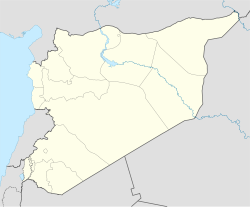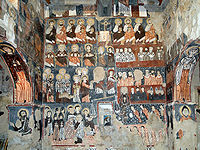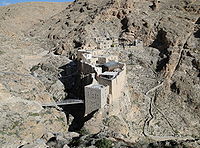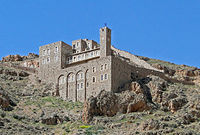- Monastery of Saint Moses the Abyssinian
-
Monastery of Saint Moses the Abyssinian 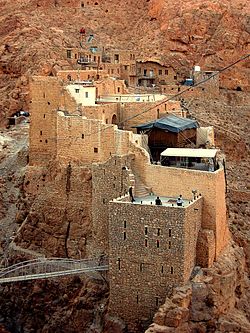
Monastery information Other Names Deir Mar Musa al-Habashi Established 6th century Dedicated to Saint Moses the Abyssinian Diocese Syriac Catholic Church People Site Location Nabk, Syria Coordinates 34°1′18″N 36°50′32″E / 34.02167°N 36.84222°ECoordinates: 34°1′18″N 36°50′32″E / 34.02167°N 36.84222°E Public Access Yes Mar Musa or Deir Mar Musa al-Habashi (Syriac: ܕܝܪܐ ܪܡܪܝ ܡܘܫܐ ܚܒܫܐܝܐ deiro d'mor mūše ḥabšoyo ;Arabic: دير مار موسى الحبشي dair mār mūsā al-ḥabašī, literally The Monastery of Saint Moses the Abyssinian) is a monastic community of Syriac Catholic rite, situated near the town of Nabk, approximately 80 kilometers north of Damascus. The main church of the monastic compound hosts precious frescoes dating to the 11th and 12th century CE.
History
The area was first inhabited by prehistoric hunters and shepherds because of its natural cisterns and pastures ideal for herding goats. Perhaps the Romans built a watchtower here. Later, Christian hermits used the grottoes for meditation, and thus created the first small monastic center.
According to local tradition St. Moses the Abyssinian was the son of a king of Ethiopia. He refused to accept the crown, honors, and marriage, and instead he looked towards the kingdom of God. He traveled to Egypt and then to the Holy Land. Afterward, he lived as a monk in Qara, Syria, and then as a hermit not far from there in the valley of what is today the monastery. There he was martyred by Byzantine soldiers. The story says that his family took his body, but that the thumb of his right hand was separated by a miracle, and was left as a relic, now conserved in the Syrian church of Nabk.
The monastery of St. Moses existed from the middle of the sixth century, and belonged to the Syrian Antiochian Rite. The present monastery church was built in the Islamic year 450 (1058 AD), according to Arabic inscriptions on the walls, which begin with the words: "In the name of God the Merciful, the Compassionate". The frescoes go back to the 11th and 12th centuries. In the fifteenth century the monastery was partly rebuilt and enlarged, but by the first half of the nineteenth century it was completely abandoned, and slowly fell into ruins. Nevertheless, it remained in the ownership of the Syrian Catholic diocese of Homs, Hama, and Nabk. The inhabitants of Nabk continuously visited the monastery with devotion, and the local parish struggled to maintain it. In 1984, restoration work began through a common initiative of the Syrian State, the local Church, and a group of Arab and European volunteers. The restoration of the monastery building was completed in 1994 thanks to cooperation between the Italian and Syrian States. An Italian and Syrian school for restoration of frescoes has been created at Deir Mar Musa and will complete the work in the context of Syrian European cooperation. The new foundation of the monastic community started in 1991.
Frescoes found at the monastery
The church of the monastery was built in 1058 AD. The space is about 10x10 metres squared and is divided into two sections. The larger of these is a nave with two aisles and is illuminated by a high eastern window. The second section is the sanctuary, which contains the altar and the apse and is separated from the rest of the church by a stone and wooden chancel screen. Thus far, three layers of frescoes have been revealed. The first layer is from the middle of the eleventh century AD, the second is from the end of the eleventh century, and the third is from the end of the twelfth or beginning of the thirteenth century. The images of the most recent layer are fairly complete, and comprise two well integrated iconographic cycles. The first and larger cycle focuses on the dimension of sacred history. The second, in the sanctuary, represents the Mystery of the eternal and present Instant. The first cycle begins with the image of the Annunciation. Gabriel stands on the north side and the Virgin Mary stands on the south side of the east window; the Emmanuel, the infant Jesus, the sun of justice, rises above. (This image was destroyed, together with other images, in 1983 and was later partially reconstructed out of pieces.) Beneath the window, Jesus Christ with apostles and evangelists inaugurates the time of the Church, which receives sustenance from the Mystery of the Temple, the Holy of Holies. The nave of the church is decorated with saints, women in the arches and men on the pillars. The four evangelists are painted above the four columns looking upwards to copy a heavenly page with Syriac letters in their Gospels. Six martyr saints, painted as knights on the highest part of the nave, ride towards the East fighting the good battle of faith.
The second cycle, that of the actuality of the Mystery, is expressed beginning from the door of the Temple. On the external face of the stone part of the screen, at the door to the sacred space of the altar, the ten virgins of the gospel of Matthew 25 were painted. Very little remains of this painting but it has been possible to partially reconstruct the images. Five had lights burning in their right hands. Five had extinguished lights in their left hands. Behind the altar stands the Holy Virgin, her Child sitting on the throne of her womb. Around her stand the Fathers of the Church. In the semi-dome of the apse, above the altar, we can still see something of the representation of Christ as Son of Man, on his throne and surrounded by cherubim. Mary, the mother of the Saviour, and John the Baptist are painted in the large arc close to the throne, to act as intercessors.
The two cycles, one of history and one of sacrament, are linked together in the great representation of the final judgment on the west wall of the nave. The highest part of the fresco is lost and probably represented Christ in his glory giving Peter the keys to the Kingdom. Peter is still visible standing on the right side, with Paul to the left. Beneath the west window, we see the cross with the symbols of the passion of Jesus: nails, ladders, and the crown of thorns. On the top of the throne, painted in the oriental fashion with cushions and carpets, we see the white shroud, symbol of his resurrection from the tomb. Sitting on the left and right, acting as judges, are ten apostles and evangelists. With Peter and Paul, they complete the number of twelve. The rest of the representation is divided between the right (Paradise) and left (Hell). In Paradise, beneath the throne, Adam and Eve pray for all their children. Beside them the saved people are in the embrace of the Virgin Mary, Abraham, Isaac and Jacob. In the next level, two angels play the trumpets of judgment, and the prophets Moses with Elijah and David with Solomon stand together with the Fathers of the Church. In the next level lies the niche, which probably held the relic of St. Moses. Beside it, an angel of intercession pulls down the plate of good deeds of the scales of divine justice. Close to him, Saint Peter opens the little door of Paradise with a white key. The martyrs St. Stephen and St. James enter first, together with four ancient Syrian monks and three nuns. On the left, beneath the thrones of the apostles, different groups of bishops suffer the pain of fire and cry bitter tears. Beneath them sinners belonging to different cultures and religions suffer the effects of a heavy rain of fire. Under them, beside a terrible Satan strangling an impious individual, monks and nuns burn in hell. Lower still a small devil, with a red tongue of scandals and lies, pulls the left plate of the balance, the one of bad deeds. Close to him are represented four sinners bound like mummies, with the symbols of their sins tied to their necks. The first worshipped money, the second was violent, and perhaps the third was an usurer. The last was a dishonest trader who cheated with his balance. In the end, a line of naked men and women tied with a chain, with snakes entering their bodies through the doors of senses, represent the condemnation of adultery and fornication. At the bottom, a painted base of coloured marble perhaps indicates the final crystallization of the material world.
On the second layer of frescoes, in the northern aisle near the baptistery, rests an image of the baptism of Jesus with an angel serving as a deacon, and with St. Simeon Stylites sitting atop his column.
On the southern wall of the nave, on top of the first pillar, we admire an Elijah from the first period, ascending in his chariot.
External links
- The official site of Deir Mar Musa al-Habashi
- Pictures of Deir Mar Musa (scroll to bottom)
Syriac monasteries Syria: Ma'arrat Saidnaya
Iraq: Mar Mattai
Turkey: Mor Hananyo · Mor Gabriel · Mt. Izla · Mor Malke · Mor Hobil and Mor Abrohom
Netherlands: Mor Ephrem
Switzerland: Mor Augin
Germany: Mor Ya'qub of SarugCategories:- Christian monasteries in Syria
- Syriac Catholic Church
Wikimedia Foundation. 2010.

